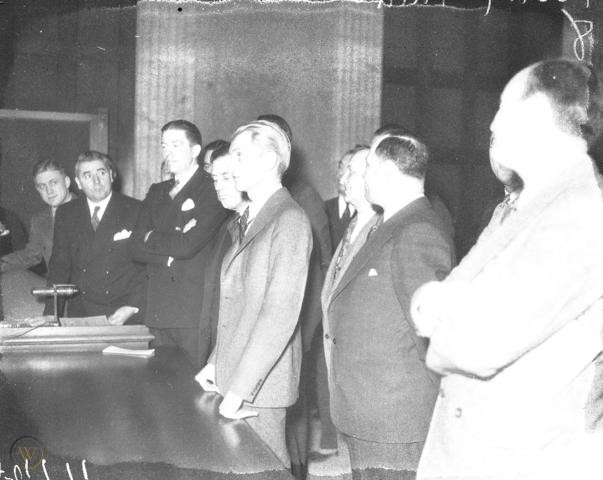The Berkshire Depot Job
The Berkshire Depot Job
At about 6
a.m. on Jan. 31, 2002, two security guards started their shift on a snowy
day at the Berkshire Armored Car Services Depot in Rutland,
Vermont. Shortly after they arrived, a lone masked gunman with a
thick New York accent entered and tied them up. He made
off with $1.9 million. Police got a partial palm print from the perpetrator,
but never made a match. The robbery remains the biggest in
Vermont history.
A
car careened in front of a mail truck, breaking Charlotte’s morning calm Nov.
15, 1933. Four men bounded out of the car, one armed with a Tommy gun, to
commit the biggest crime yet in this sleepy city of 80,000.
They
disarmed the driver and cut off the lock with wire cutters. Mobsters
grabbed Charlotte Federal Reserve sacks just picked up from the train
depot. The gangsters sped off with more than $100,000 (worth more than
$1.8 million in today’s dollars) in cash and bank notes.
Chief
of Detectives Frank Littlejohn arrived on the scene to
investigate the heist. Only a few days before he had gotten a tip that
something big was going to go down in the Queen City.
A
tall, lanky man, Littlejohn had a big nose and an outsized ego to match. He was
good, and he knew it. FBI Director J. Edgar Hoover called him the “Finest
detective in the world”
The
Pacolet, S.C., native moved to Charlotte in 1917 to run a shoe store. In the
1920s, Littlejohn worked as an undercover federal agent to
infiltrate the Ku Klux Klan.
Charlotte
hired him for 80 days in 1927 to bust an uptown prostitution ring. The shoe
salesman stayed on the police force for 30 years, rising to the rank
of Police Chief.
THE GETAWAY CAR
Soon after the robbery, police found the getaway
car outside the city limits. Thieves had stolen the new black
Plymouth from East Morehead Street two weeks before knocking off the mail
truck.
Littlejohn told cops to drive every route to
determine where the thieves had been hiding. He instructed postal carriers
to ask if anyone on the routes had recently rented a garage.
A woman on 10th Street had important information. She had
rented a room to two men, and arranged for them to use her neighbor’s
garage.
The landlady had seen them heading west on foot.
Littlejohn and his men knew there were two more bandits.
They, too, headed west.
Following a tip about an unfamiliar car near the site of the Plymouth’s
theft, police found the second hideout. The occupants had left in a hurry.
Littlejohn sorted through the detritus left behind. Twenty-seven pieces
of torn paper, when reassembled, turned out to be a Chicago rent
receipt.
He got descriptions from the landlady, who told them that one of
the men was always carrying a violin case. He surmised that was for the Tommy
gun. Based on the receipt, descriptions and fingerprints, Littlejohn
hit the road to Chicago.
MEANWHILE IN CHICAGO
Al Capone and Roger “The Terrible” Touhy were in a struggle for
supremacy for Chicago’s illegal liquor trade. Capone framed Touhy in
the kidnaping of brewery magnate William Hamm. This was one
crime he hadn’t committed.
So, Touhy sent his men to Charlotte to raise much needed cash for
his court defense.
Touhy hadn’t figured on Littlejohn’s prowess and determination.
Two weeks after the crime, Littlejohn had rounded up most of Touhy’s
gang. Basil “The Owl” Banghart, Ludwig “Dutch” Schmidt, and Isaac Costner
were behind bars. Each man spent more than 30 years in prison for the crime.
Police found the body of Charles “Ice” Connors in an alley. It was
riddled with machine gun slugs and wrapped in barbed wire.
Touhy beat the Hamm kidnaping frame-up. Then, Capone framed
Touhy in the kidnaping of Jake “The Barber” Factor, brother of
cosmetics impresario Max Factor.
Touhy beat this rap, too. He was not prosecuted for his part in
the Charlotte hold-up.
Charlotte Police detectives upon receiving awards from J. Edgar
Hoover for their part in solving a bank robbery by the Touhy gang on Nov. 15,
1933. The photograph was taken in front of the courthouse. From left to right,
unknown, Frank N. Littlejohn, Harry M. Joyner and unknown. Littlejohn later
beame the Chief of Police.
Littlejohn continued his service and spent 12 years as Chief
of Police.
Always outspoken, Littlejohn publicly criticized a 1958 City
Council decision. City fathers fired him 15 days before his scheduled
retirement.
Harry
Hoover first wrote about Frank Littlejohn and the heist as a crime reporter in
the 1980s. The information in this story comes from his research and media
reports about the crime.
Jake the Barber
1932 in Chicago
Top and bottom photos are Factor in Chicago testifying in court that he had no knowledge of the Touhy murder. Actually, he was the cause of it because he was running the Stardust Casino (on paper) for the mob who didn't want Touhy to drag Las Vegas into his pending lawsuit against Factor,
Subscribe to:
Posts (Atom)

































